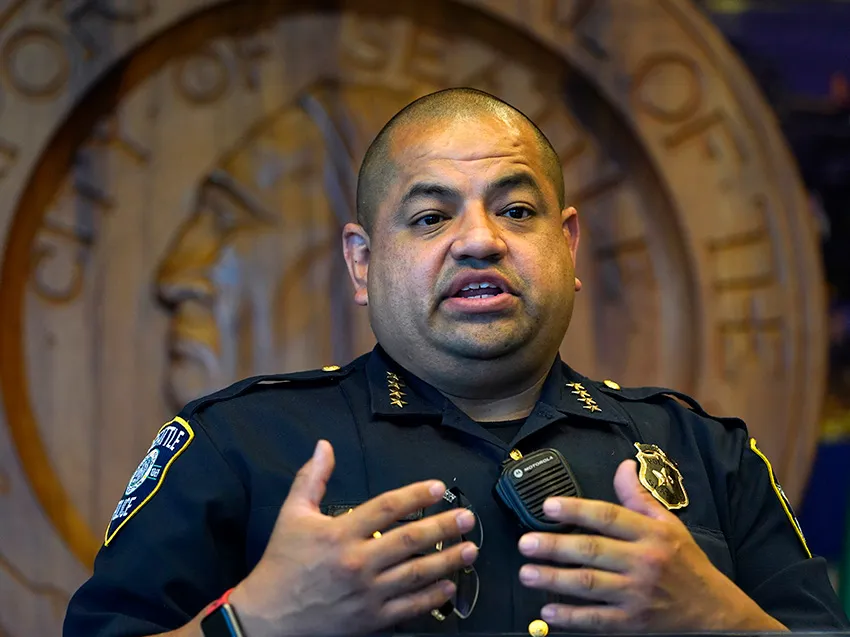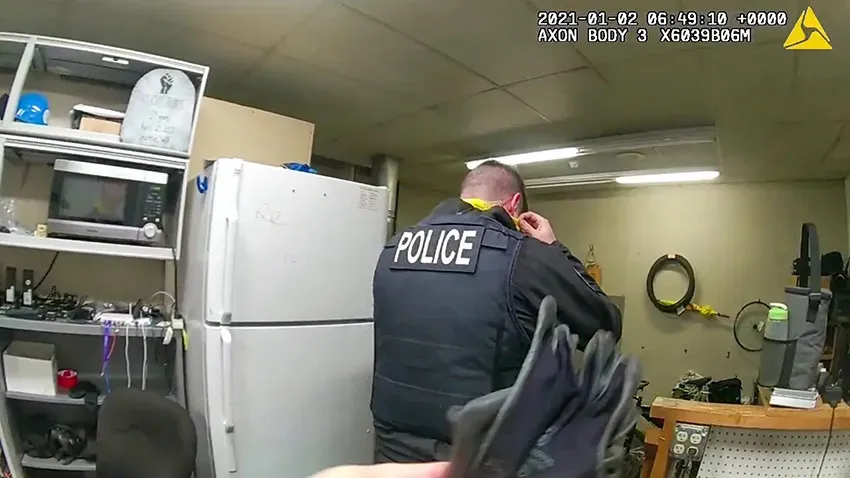In January 2021, protesters used charcoal and chalk to write on temporary concrete "eco-block" walls stacked outside the Seattle Police Deapartment's East Precinct. Four protestors who wrote political statements that would wash off in the rain were arrested. Subsequently, a lawsuit was filed against the City of Seattle regarding the constitutionality of the arrests and the SPD's double standard when chalk statements are pro-police.
As part of the lawsuit, police body-cam footage of the arrests was recently released. It showed officers in a break room standing up to respond to the vandalism report. As they left, the body-cam captured the decorations along the walls. A Trump flag was hung in a place of prominence next to a mural of the precinct's mascot, with the American flag on the other side. Along the wall to the right of the mural were shelves that visibly contained what Braden Pence, attorney for the plaintiffs in the graffiti lawsuit, said was "disturbing trophies and iconography."
The most upsetting item sat just above the break room's microwave: a mock tombstone for Damarius Butts, a young Black man who, after fleeing a robbery, was killed by officers after an exchange of gunfire. Butts died on April 20, 2017, and an inquest jury found the shooting justified.
The origin of the tombstone has not been verified. Still, the legal director of ACLU Washington, La Rond Baker, said that it appears that the tombstone was taken from a BLM memorial for people killed by police.
Following the release of the footage, community members were outraged, and the Office of Police Accountability (OPA) began an investigation. Chief Adrian Diaz also ordered an investigation of all precincts to ensure that the decor meets department policy and standards.

Many questions to answer
On July 19, the Community Police Commission asked that Chief Diaz attend a meeting to answer questions about the incident. Chief Diaz attended the meeting virtually and said, "I wish I were here in better circumstances. In 2021 I acknowledged the impacts that we created after George Floyd's murder, and I apologize for those impacts. Those impacts that we're discussing today, they've created deep mistrust. But our department is committed to making it right, and I'm committed to making it right."
He continued, "These images bring back hurt and trauma. I've talked to community members about this hurt, and I've talked with officers. They were embarrassed and expressed that they can't have this. It's unacceptable, and we'll work with OPA regarding the situation. While we know these items are no longer up, my focus is that we rebuild trust." He emphasized that SPD culture is in the process of changing and that that change takes time.
A line of questions from Commissioner Adrien Leavitt followed. "I want to know who took the memorial to Damarius," he said. "I want to know where it was taken from and who brought it to the East Precinct. [I want to know] who displayed it. I want to know how long it was there. I want to know how many officers saw it and did not say anything... I want to know when it was removed... I have questions about whether anyone was ever held accountable."
Chief Diaz said that the SPD is working with the OPA to get answers to those questions. He shared that the East Precinct captain was Eric Sano at the time. Diaz, when answering about who was involved, reminded the listeners that over 500 officers had left the department and the East Precinct specifically. It is still unknown whether those who were responsible and complicit in the incident are still with the SPD. When answering about SPD culture, he said they're investing in and promoting initiatives that help create an officer who healthily interacts with the community.
Damarius Butt's mother, Stephanie Butts, said, "My son was a loving son, brother, father, and much more. Every day we miss him. Our family hasn't been the same since that day. He was my first child and the first grandchild to my parents.
"Damarius was killed on April 20, 2017, by the Seattle Police Department. The day that I lost my son was the worst day of my life.
"When I first heard that the SPD displayed a fake tombstone with my son's name on it, I was shocked. I can not explain the pain and anger that I felt. It was very hurtful to know that the SPD joked about killing my son."
Her voice cracked with emotion as she continued, "That SPD officers were so callous that they warmed up food below my son's fake tombstone and didn't see anything wrong with that... I want to know why this happened and why this was allowed to continue. I want to know if anyone has been held accountable. I want to know what is being done so that it never happens again. I want to know why killing my son and getting away with it wasn't enough. I want answers, and so far, I haven't heard any."
Chief Diaz responded, saying he doesn't want this to happen again and wants answers. He said that is why they are working with the OPA and investigating to hold those responsible accountable.
Commissioner Joel Merkel thanked Stephanie Butts for speaking and added, "Damarius Butts was entitled to dignity, and his family was entitled to dignity."
The trophy and decorations in the break room are gone, but the hurt felt by the community and the Butts family are not. Though the SPD, through the leadership of Chief Diaz, has been trying to repair relationships, and working on growing a culture that humanizes those they protect and serve through more presence at Advisory Council meetings and programs like Before the Badge, injustices like this damage its attempts to build trust.


